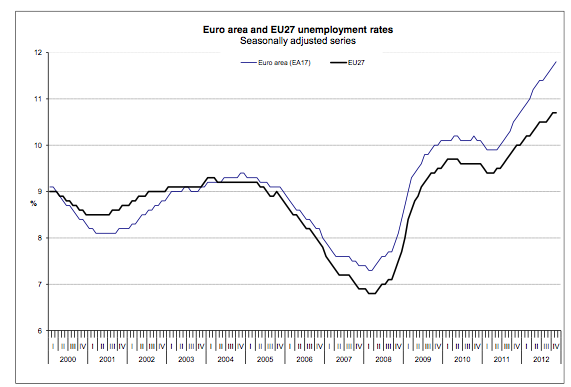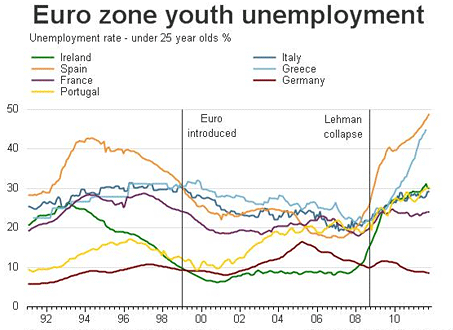The start of 2013 has been much like late 2012 in terms of stability on the European markets, but I’ve been warning for a few months that the data coming from the real economies of at-risk eurozone nations isn’t playing along. Earlier this week we saw the latest PMI data which showed that Italy, France and Spain are all seeing further signs of economic contraction which, given the relative sizes of these economies, still presents a significant risk to the zone. On top of this the latest data from the ECB shows that private sector lending is still contracting and a number of countries are digging into one-off funds in order to balance the books in the short-term.
I’ve explained previously that the policy response to the economic crisis is one that, in the absence of increased foreign demand, guarantees lower economic activity within the eurozone which in turn is leading to higher unemployment and therefore a reduction of government revenues and a rise in bad debts in the banking system. Markets have obviously been concentrating on sovereign yields as a measure of success, but my own opinion is that you can really only say that the Europe has turned a corner once unemployment begins to fall, and of most concern are those nations already under economic stress.
This brings us to last night Eurostat report on European unemployment:
The euro area (EA17) seasonally-adjusted unemployment rate was 11.8% in November 2012, up from 11.7% in October. The EU27 unemployment rate was 10.7% in November 2012, stable compared with October. In both zones, rates have risen markedly compared with November 2011, when they were 10.6% and 10.0% respectively. These figures are published by Eurostat, the statistical office of the European Union.
Eurostat estimates that 26.061 million men and women in the EU27, of whom 18.820 million were in the euro area, were unemployed in November 2012. Compared with October 2012, the number of persons unemployed increased by 154 000 in the EU27 and by 113 000 in the euro area. Compared with November 2011, unemployment rose by 2.012 million in the EU27 and by 2.015 million in the euro area.
Among the Member States, the lowest unemployment rates were recorded in Austria (4.5%), Luxembourg (5.1%), Germany (5.4%) and the Netherlands (5.6%), and the highest in Spain (26.6%) and Greece (26.0% in September 2012).
Compared with a year ago, the unemployment rate increased in eighteen Member States, fell in seven and remained stable in Denmark and Hungary. The largest decreases were observed in Estonia (12.1% to 9.5% between October 2011 and October 2012), Latvia (15.7% to 14.1% between the third quarters of 2011 and 2012), and Lithuania (13.9% to 12.5%). The highest increases were registered in Greece (18.9% to 26.0% between September 2011 and September 2012), Cyprus (9.5% to 14.0%), Spain (23.0% to 26.6%) and Portugal (14.1% to 16.3%).
Between November 2011 and November 2012, the unemployment rate for males increased from 10.4% to 11.7% in the euro area and from 9.9% to 10.8% in the EU27. The female unemployment rate rose from 10.9% to 11.8% in the euro area and from 10.1% to 10.7% in the EU27.
The chart below highlights the solid trend in the data.

and youth unemployment remains woeful.

As you can see from the report below, Greece, Spain, Italy, Portugal, France and Cyprus are all seeing rising unemployment and as we know these are nations who are most at risk through 2013, although I must admit I’m also quite concerned about The Netherlands.
Overall, although there is some good news buried in it, it’s another very concerning report and shows there is still a very long way to go in the euro crisis.
Full report below: